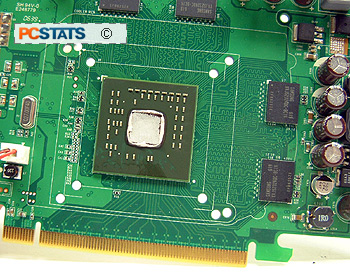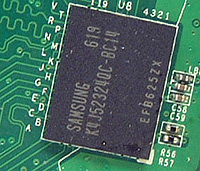 |
| Overclocking Results: |
|
|
Overclocking
the Biostar Simga-Gate GeForce 7600GS is a more interesting affair
than with any previous videocard PCSTATS has tested, precisely because we
have direct control over GPU and memory voltages. Owing to the extra
dimension in Biostar's overclocking palate, we'll first
overclock the videocard using its stock memory and GPU voltages. Then,
PCSTATS will overclock this Biostar 7600GS with the memory and
GPU voltage bumped up! ;-) This is going to be fun!
Starting with the core first which has a stock speed of 400 MHz,
the clock speed was increased in 10 MHz intervals. The GeForce 7600GS core had plenty
of speed in it, and without much difficulty broke the 500 MHz threshold. Continuing, we were
able to overclock the 7600GS past 550 MHz to a top speed of 560
MHz. That's a 160MHz overclock above the default 400 MHz core speed. Not bad at all.
The 256MB of Samsung GDDR3 memory used on
the Biostar Geforce 7600GS videocard is clocked at 1400 MHz. We chose
to overclock the memory much more aggressively with 20 MHz increments. The memory
handled this remarkably well, easily passing 1500 MHz and 1600 MHz before settling
on a top speed of 1620 MHz. In both cases, the GPU and memory voltages remained at their stock
values, 1.149V and 1.823V respectively.
 Using Biostar V-Ranger to Overclock Videocard
GPU/Memory Voltages
Using Biostar V-Ranger to Overclock Videocard
GPU/Memory Voltages
Now this is where the fun begins, and let me
just tell you - it was a blast - to overclock this Biostar GeForce 7600GS videocard!
With the Geforce 7600 core already overclocked to 560 MHz,
we used Biostar's V-Ranger software to increasing the core voltage to 1.21V (stock
is 1.149V), and began overclocking the GPU in 5 MHz steps. That slight voltage bump
allowed the videocard to do 585 MHz, but to go even higher the GPU required more
juice... With 1.25V supplied, the Geforce 7600GS overclocked past 600 MHz. Pretty awesome eh? We're not even done yet.
A few more frequency jumps quick brought us to 630
MHz, and then the GPU voltage needed another small bump up. With 1.34V
feeding the GeForce 7600GS GPU, PCSTATS was able to overclock it to a
maximum speed of 680 MHz. Above this speed the V-Ranger test tool
complained of instability. Further voltage increases didn't help either...
and more than likely heat may have been the culprit as V-Ranger reported
the GPU running at close to 70 degrees Celsius! If you plan to heavily overclock
the Biostar Sigma-Gate GeForce 7600GS, and leave it that way, do yourself a
favor and slap on a good Zalman VF900-Cu VGA heatsink.
Over-volting the Videocard Memory with V-Ranger
 The Samsung GDDR3 memory was
not about to let the Geforce 7600GS core show it up, it turned play
nicely with higher voltages too. Starting at the already overclocked speed of 1620 MHz, the
memory voltage was increased to 1.85V from 1.823V. This change allowed the memory to hit
1650 MHz. Nice!
The Samsung GDDR3 memory was
not about to let the Geforce 7600GS core show it up, it turned play
nicely with higher voltages too. Starting at the already overclocked speed of 1620 MHz, the
memory voltage was increased to 1.85V from 1.823V. This change allowed the memory to hit
1650 MHz. Nice!
We
ran into a bit of a problem shortly thereafter because V-Ranger's memory frequency maxes out at
1680 MHz, and the videocard GDDR3 had no problem whatsoever running at that speed with 1.9V. To
overclock past 1680MHz we had to adjust voltage options in V-Ranger and overclock the speed
in the other utility, Sigma-Gate.
I'll spare you the play by play action, but suffice to
say the maximum speed PCSTATS was able to push the Samsung GDDR3 was 1752 MHz
(at 2.0V)! It was still possible to increase the memory voltage further
than this, but because the RAM was running extremely hot we didn't want to risk
damaging the videocard permanently. On that note, we should make
it clear that overvolting both the GPU and memory is probably going to
shorten the lifespan of both components, but by how much just isn't
known.
The voltage options that the Biostar V-Ranger
overclocking utility provides can go high enough to damage your hardware. The disclaimer wouldn't be there if
this tool didn't pack a serious punch, so use it carefully. Be nice to your
videocard, and use caution when overclocking with increased voltages. Make certain the
videocard has sufficient cooling, and that voltages are only increased as much as is absolutely necessary. And
remember above all else, overclocking more than likely voids a stack of warranties.
:-)
Prelude to
Benchmarks
The details of how the Biostar Simga-Gate GeForce 7600GS
test system was configured for benchmarking; the specific hardware, software
drivers, operating system and benchmark versions are indicated below. In the
second column are the general specs for the reference platforms this nVIDIA
GeForce 7600GS based videocard is to be compared against. Please take a moment
to look over PCSTATS test system configurations before moving on to the
individual benchmark results on the next page.
 |
| PCSTATS Test System Configurations |
|
|
